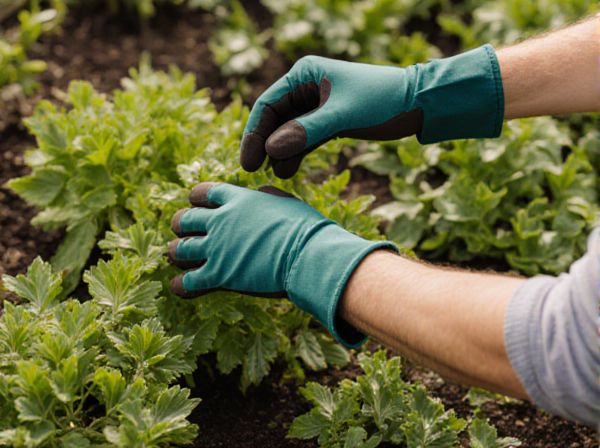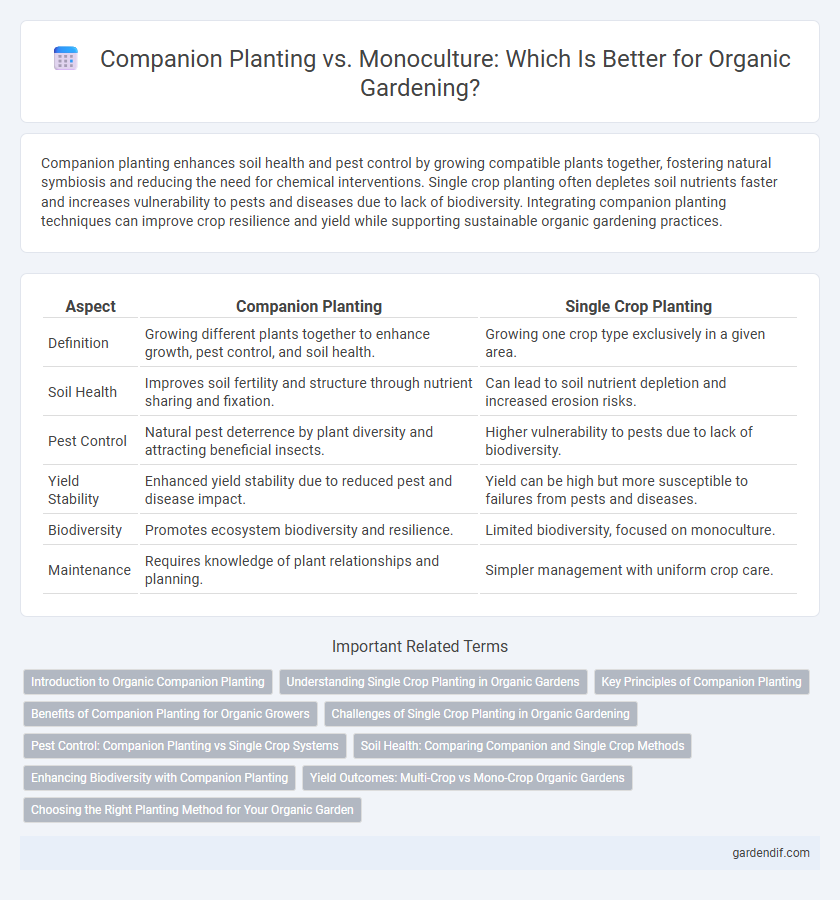
Companion Planting vs Single Crop Planting Illustration
Companion planting enhances soil health and pest control by growing compatible plants together, fostering natural symbiosis and reducing the need for chemical interventions. Single crop planting often depletes soil nutrients faster and increases vulnerability to pests and diseases due to lack of biodiversity. Integrating companion planting techniques can improve crop resilience and yield while supporting sustainable organic gardening practices.
Table of Comparison
| Aspect | Companion Planting | Single Crop Planting |
|---|---|---|
| Definition | Growing different plants together to enhance growth, pest control, and soil health. | Growing one crop type exclusively in a given area. |
| Soil Health | Improves soil fertility and structure through nutrient sharing and fixation. | Can lead to soil nutrient depletion and increased erosion risks. |
| Pest Control | Natural pest deterrence by plant diversity and attracting beneficial insects. | Higher vulnerability to pests due to lack of biodiversity. |
| Yield Stability | Enhanced yield stability due to reduced pest and disease impact. | Yield can be high but more susceptible to failures from pests and diseases. |
| Biodiversity | Promotes ecosystem biodiversity and resilience. | Limited biodiversity, focused on monoculture. |
| Maintenance | Requires knowledge of plant relationships and planning. | Simpler management with uniform crop care. |
Introduction to Organic Companion Planting
Organic companion planting enhances biodiversity by strategically growing compatible plants together, which improves pest control, nutrient uptake, and soil health compared to single crop planting. This sustainable method reduces the need for synthetic pesticides and fertilizers, promoting natural ecosystems and increasing crop resilience. Popular organic companion plants include marigolds, basil, and beans, which protect and nourish their neighbors in an eco-friendly garden.
Understanding Single Crop Planting in Organic Gardens
Single crop planting in organic gardens involves cultivating one type of plant in a designated area, which can simplify pest and nutrient management but may increase vulnerability to diseases and pests. This method requires careful soil fertility management through organic amendments like compost and green manures to maintain nutrient balance. Understanding soil health and crop requirements is essential to optimize growth and maintain sustainability in organic single crop systems.
Key Principles of Companion Planting
Companion planting enhances garden biodiversity by strategically pairing plants that support each other's growth, pest resistance, and nutrient uptake, unlike single crop planting that often depletes soil nutrients and increases vulnerability to pests. Key principles include selecting complementary plant species that attract beneficial insects, improve soil health through nitrogen fixation or ground coverage, and provide natural pest deterrence without synthetic chemicals. Utilizing companion planting techniques promotes sustainable organic farming by optimizing space and fostering resilient ecosystems.
Benefits of Companion Planting for Organic Growers
Companion planting enhances biodiversity, naturally deterring pests and reducing the need for chemical pesticides in organic gardens. This method improves soil health by promoting nutrient cycling and microbial activity, leading to more resilient and fertile soil. Organic growers benefit from increased crop yields and better plant health through synergistic plant relationships that optimize space and resources.
Challenges of Single Crop Planting in Organic Gardening
Single crop planting in organic gardening often leads to increased vulnerability to pests and diseases due to reduced biodiversity. Soil health can degrade rapidly as nutrient depletion occurs without the natural replenishment provided by diverse root systems. This practice limits ecosystem resilience, making it difficult to maintain sustainable, healthy organic gardens.
Pest Control: Companion Planting vs Single Crop Systems
Companion planting enhances pest control by attracting beneficial insects and repelling harmful pests through strategic plant combinations, reducing the need for chemical interventions. Single crop planting systems often face higher pest pressures due to monoculture vulnerability, leading to increased pesticide use and potential resistance. Integrating diverse companion plants promotes ecological balance and sustainable pest management in organic farming.
Soil Health: Comparing Companion and Single Crop Methods
Companion planting enhances soil health by promoting biodiversity, improving nutrient cycling, and reducing pest pressures through natural interactions between plants. Single crop planting often depletes specific soil nutrients and increases vulnerability to pests and diseases, leading to soil degradation. Integrating diverse plants in companion systems fosters microbial activity and organic matter, boosting soil fertility and structure sustainably.
Enhancing Biodiversity with Companion Planting
Companion planting enhances biodiversity by promoting a diverse ecosystem of plants that support natural pest control and improve soil health. This method encourages beneficial insect populations and fosters symbiotic relationships between plant species, leading to higher resilience against diseases. Unlike single crop planting, which often depletes nutrients and attracts pests, companion planting creates a balanced environment that sustains long-term agricultural productivity.
Yield Outcomes: Multi-Crop vs Mono-Crop Organic Gardens
Companion planting in organic gardens often enhances yield outcomes through improved pest control, nutrient cycling, and pollination, leading to higher productivity compared to single crop planting. Multi-crop organic systems leverage biodiversity, reducing disease prevalence and soil depletion, which sustains long-term soil fertility and crop resilience. In contrast, mono-crop organic gardens risk yield declines due to increased soil nutrient competition and vulnerability to pests, highlighting the efficiency of integrated planting strategies for optimized organic yields.
Choosing the Right Planting Method for Your Organic Garden
Companion planting enhances soil health and pest control by pairing compatible plants like tomatoes with basil, boosting organic garden productivity. Single crop planting simplifies management but may increase vulnerability to pests and soil depletion. Selecting the right method depends on crop diversity, garden size, and organic maintenance goals to optimize yield and sustainability.
Companion Planting vs Single Crop Planting Infographic

 gardendif.com
gardendif.com